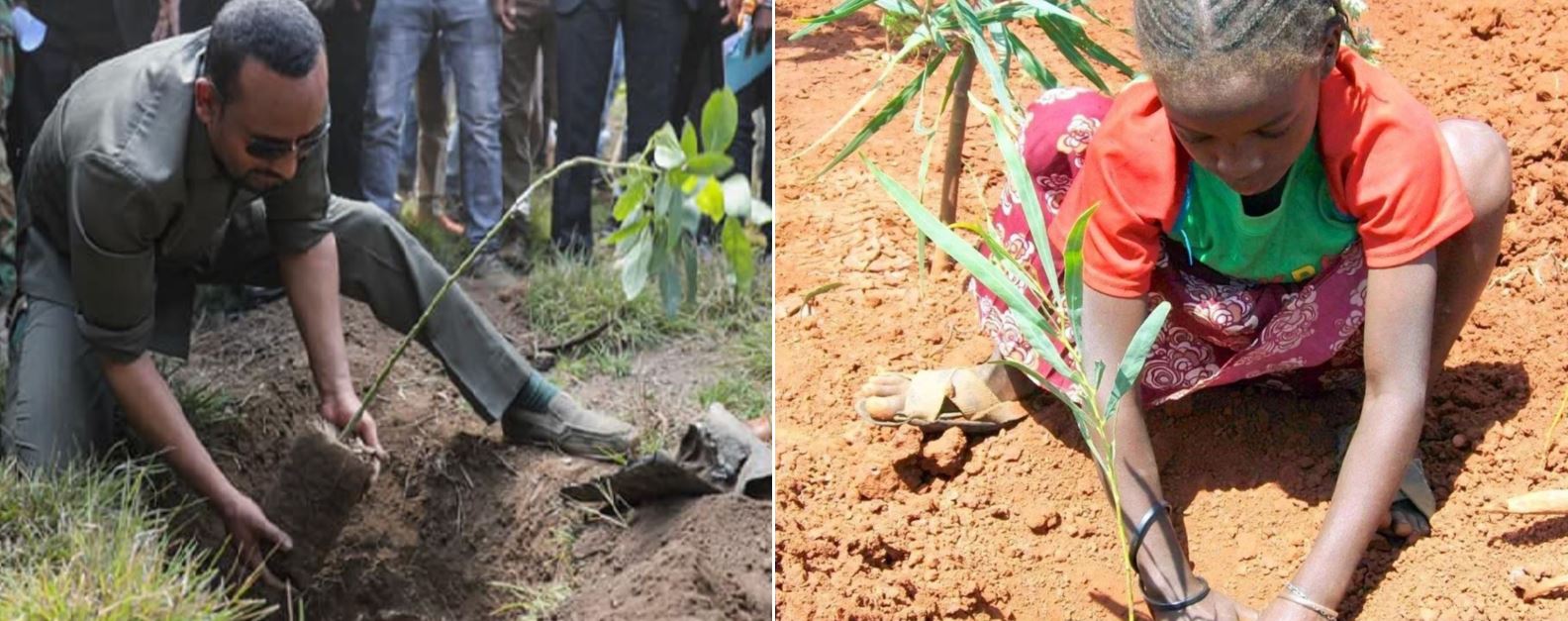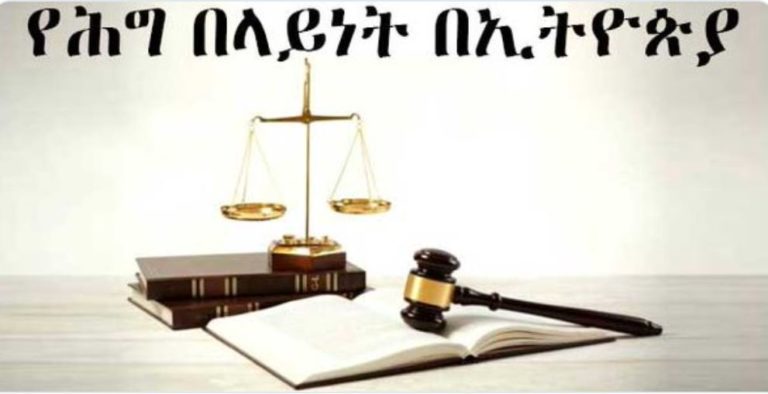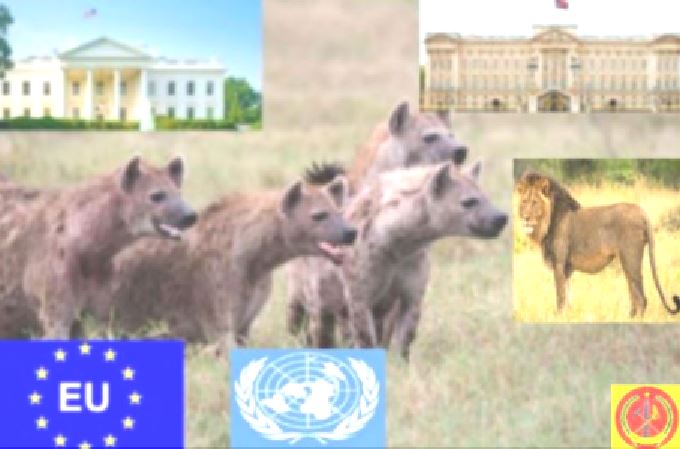Generation Abiy and the Greening of Ethiopia
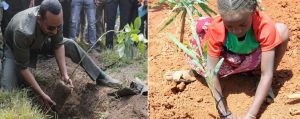 4 Billion Trees? But I asked for only for 110 million!
4 Billion Trees? But I asked for only for 110 million!
It is so wonderful to see one’s dream come true!
In February 2019, I shared a dream about the rise of a youth environmental movement in Ethiopia.
As an environmentalist and proud tree hugger, I have always had deep concern for environmental conservation in Ethiopia. I am proud of the fact that Ethiopia is home to many species of plants and animals that cannot be found anywhere else on Earth. But many of them are endangered. It is my dream to see the day when an Ethiopian youth environmental movement shall rise and plant 110 million trees (one for every Ethiopian) and join hands to save our endangered species!!!
In June 2019, “the day” I dreamed about arrived out of the blue; perhaps I should say out of the green.
Last week, H.E. Prime Minister Dr. Abiy Ahmed launched the National Green Development Program (NGDP) with the aim of planting 4 billion trees throughout Ethiopia.
I could not have been happier if I had won the California SuperLotto.
Ethiopia is the 27th largest country in the world.
The tree planting campaign is expected to cover 1 million hectares (2.5 million acres).
Government nurseries are expected to raise 3 billion seedlings and the rest will come from private suppliers.
I was deeply moved watching PM Abiy scooping dirt with his bare hands and plating trees with his knees braced in the mud.
When was the last time an Ethiopian leader got his hands and knees in the dirt planting trees just like the millions of dirt-poor farmers ploughing the land?
Never!
The “leaders” before PM Abiy did not have dirt on their hands.
They had blood on their hands.
They had blood not only on their hands but also in their minds.
I remember in February 2013, when they broadcasted a fear-mongering three-part propaganda “documentary” entitled “Akeldama” (or Land/Field of Blood) in an attempt to create a bloodbath between Ethiopian Muslims and Christians.
Ramadan Mubarak, Eid Mubarak today to all of our Ethiopian Muslim brothers and sisters.
I will forgive, but forget? Never!
But what is the big deal about trees?
Trees are the “tree of life”.
It is written that a tree in the Garden of Eden produced food which gave everlasting life.
Human life would be impossible without trees.
Trees filter the air we breathe.
Trees absorb carbon dioxide and other harmful gasses to human health from the air and release oxygen. One large tree can supply a day’s supply of oxygen for four people.
Trees create homes for untold species of plants and animals, including humans who cut tree to make homes and cook their food.
Trees are our first line of defense against climate change.
Ethiopia is green today, not red. Thanks to PM Abiy.
The grass is also greener on the Ethiopian side.
But there are also many who cannot see the greenery in Ethiopia over the past year because they walk with the green-eyed monster.
PM Abiy in his twitter message lamented, “Over the past years, Ethiopia’s forest coverage has decreased in recent years and the initiative is set to mobilize national reforestation at 40 trees per head.”
Gimmie “40 trees and a shovel”
I am like a kid in candy store when it comes to tree planting.
I have been told I have a green thumb. I like growing plants.
I just can’t wait to go back and plant my share of 40 trees as a diaspora Ethiopian from America.
Maybe I will plant 40 trees for myself and 50 more for each state in the United States.
Well, I am so happy and excited about PM Abiy’s tree planting campaign, I have decided to plant 40 of my own, 50 for each U.S. state and 195 trees for every country in the world.
Now, top that!
By the way, that is my challenge to any Diaspora Ethiopian!
It is said there are between 1-3 million Ethiopians in the diaspora. We could easily plant at a minimum anywhere between 40-120 million trees.
After the American Civil War, African Americans had a favorite phrase: “40 acres and a mule” signifying their intent to reclaim the slave plantations.
I will be promoting the NGDP in the Ethiopian Diaspora with the tagline, “40 trees and a shovel” to reclaim the all of the lost tree cover in Ethiopia.
Gimmie 40 tress and a shovel and I will be alright!
Ecosystem degradation in Ethiopia
In a recent statement, USAID reported, “Ethiopia is a classic example of how severe degradation of ecosystems and productive agricultural lands and poor utilization of water resources increase poverty, food insecurity, loss of biodiversity, and even conflict.”
In other words, we are in deep environmental crises!
The data on environmental degradation and deforestation in Ethiopia is heart breaking.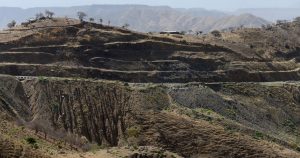
Only 11.9% —or about 13,000,000 hectares—of Ethiopia is forested.
Between 1990 and 2000, Ethiopia lost an average of 140,900 hectares of forest per year, or an average annual deforestation rate of 0.93%.
Between 2000 and 2005, the rate of forest change increased by 10.4% to 1.03% per annum.
In total, between 1990 and 2005, Ethiopia lost 14.0% of its forest cover, or around 2,114,000 hectares.
Measuring the total rate of habitat conversion (defined as change in forest area plus change in woodland area minus net plantation expansion) for the 1990-2005 interval, Ethiopia lost 3.6% of its forest and woodland habitat.
Between 2001-2017, 902,000 acres lost their tree covers.
In Ethiopia, the top 5 regions were responsible for 81% of all tree cover loss between 2001 and 2017.
The major causes of deforestation in Ethiopia “are the expansion of arable land, resettlement, deliberately placed and naturally occurring forest fires, and commercial farming.”
On the other hand, when the people do not own any land, they have little motivation to plant trees on “government owned” land.
In 2002, the regime of the Tigrean People’s Liberation Front TPLF enacted the “Environmental Protection Organs Establishment Proclamation No. 295/2002”.
That proclamation merely catalogues responsibilities and aspirations in 26 areas ranging from environmental impact assessments to enforcing international environmental agreements.
It is full of clichés about “sustainable development”, “efficient use of natural resources” and “protection of the natural environment from any harm”.
But there is nothing that proclamation that can be of practical use for environmental protection or conservation.
Suffice it to say, the proclamation was drafted for window dressing and to panhandle the West for aid by individuals who are clueless about environmental legislation.
Revising that proclamation should be a top priority.
In 2011, the TPLF regime declared “the forestry sector as one of the pillars of the green economy that the country is planning to build by 2030.”
The TPLF regime “set specific targets for the forestry sector: afforestation on 2 million ha, reforestation on 1 million ha and improved management of 3 million ha of natural forests and woodlands.”
By the time the TPLF got a swift kick in the rear end, it had done to the forestry sector what it did to the country’s treasury!
By 2019, PM Abiy had to go out and shovel dirt with his bare hands to pull back Ethiopia from a total ecological disaster just like he pulled Ethiopia from a total political disaster in 2018.
And that is a fact!
Volunteerism and environmental conservation in the NGDP
To me, PM Abiy’s 4 billion tree planting campaign is much more than enhancing the tree cover of Ethiopia.
By launching the NGDP, PM Abiy has set in motion a massive volunteerism and environmental conservation program in Ethiopia.
The NGDP plants not only trees but also the seeds of a national environmental movement that is sorely needed and long overdue.
The NGDP could be the first and largest volunteerism program in Africa.
When the French political commentator Alexis de Tocqueville traveled in the U.S. in the 1830s, he was most impressed by the fact that Americans organically created voluntary civil associations with friends and neighbors to accomplish personal, social and economic goals.
de Tocqueville wrote in Democracy in America (p. 581), “Americans group together to hold fêtes, found seminaries, build inns, construct churches, distribute books, dispatch missionaries to the antipodes. They establish hospitals, prisons, schools by the same method. Finally, if they wish to highlight a truth or develop an opinion by the encouragement of a great example, they form an association.”
de Tocqueville felt the spirit of volunteerism shaped America as a democratic society with egalitarian values.
Today, American children are taught the virtue of volunteerism at home and school from an early age.
According to the U.S. Bureau of Labor Statistics, 62.6 million Americans volunteered in 2015 with a median number of 52 volunteer hours per year.
One of the oldest volunteer service activities in the U.S. is saving and planting trees.
Since 1882, Arbor Day (day of celebrating and planting trees) is celebrated in nearly every state in the U.S. in different months.
In 2004, Congress passed legislation making oak America’s National Tree.
I am hopeful Ethiopian children will also be taught at home and school the value and virtue of volunteerism and offer their services in all areas of social need.
I am hopeful next year Ethiopia will officially join the dozens of countries that celebrate Arbor Day.
I am also hopeful Ethiopia’s parliament will declare a national tree in the foreseeable future.
There is a large list of unique trees in the “The Red List of Endemic Trees & Shrubs of Ethiopia and Eritrea” from which to choose.
My life as a tree hugger goes way back
I pride myself as a committed environmentalist. A tree hugger is a committed environmentalist who would hug a tree to prevent it from being cut.
The first movement I joined when I came to the U.S. nearly fifty years ago was NOT the anti-war movement, the civil rights movement, the free speech movement or even the hippie counterculture movement. Those came later.
The first movement I joined in America was the environmental movement.
The early 1970s marked the beginning of environmental activism in America.
The U.S. Environmental Protection Agency was established the year I came to the U.S.
Massive dumping of toxic waste on land and in the water were highly controversial issues.
By 1980, Congress had established the Superfund program to cleanup sites highly contaminated with hazardous substances and pollutants.
There were popular movies such as the China Syndrome dramatizing the runaway meltdown of a nuclear plant and destruction of the environment.
But the reason I joined the environmental movement was not because of environmental disasters in the U.S.
The real reason was DDT (Dichlorodiphenyltrichloroethane).
DDT was something that was close and personal to me.
I was deeply moved by Rachel Carson’s “Silent Spring”, a beautifully written book about the indiscriminate use of pesticides, and specifically DDT, and the disastrous ecological consequences for life on the planet.
In the first chapter of the book entitled, “A Fable for Tomorrow”, Carson talked about an unnamed American town, in gut-wrenching terms, where all life had been “silenced” by the effects of DDT, “the most powerful pesticide the world had ever known.”
DDT was extremely effective against malaria and other pests.
The problem was DDT not only killed birds, fish, bees and other animals by the tens of millions, it also remained potent in the soil and surfaces for a prolonged period of time causing ecological devastation.
Carson’s message was if we continue to use such chemicals we will end with a silent world as insects, bees and food chain would collapse.
Carson’s book made environmentalism a personal issue for me.
I remember DDT as a child in Ethiopia in the mid-1960s.
The white powder of DDT was not only used to kill malaria mosquitoes in the countryside but also given widely to the population, including children, for delousing and sprayed on houses and crops.
Despite its proven toxicity one-half century ago, even today, TODAY, DDT is illegally sold on the black market in Ethiopia and bought by some unscrupulous farmers who raise khat.
In college, one of my dreams was to return to Ethiopia after completing my studies and help start an environmental movement.
(Oh, yes! The younger generation today should know back in those days no Ethiopian ever wanted to go to America or anywhere else for education and remain there. To the last man and woman, all of us wanted to go back and help our country! But as the poetic line goes, “The best laid plans of mice of men often go awry…”)
For nearly five decades, I have been a member of various environmental organizations (civic associations) including the Sierra Club, The Nature Conservancy, The Environmental Defense Fund, Audubon Society, The National Geographic and others.
I enjoy hitting the back-country trials in Yosemite National Park, the Grand Canyon or the Mojave Desert or the switchbacks of Southern California’s mountain ranges.
When I returned to Ethiopia in 2018 after 48 years, save a few months in 1974, I had a chance to travel to many parts of the country by plane and car.
The forests of Bale Zone were breathtaking. But even there deforestation and forest fires had taken their toll.
In many part of Ethiopia, the effects of deforestation from an aerial view was heartbreaking.
Nearly one-half century ago when I left Ethiopia, I recalled seeing trees throughout the countryside. There were many forests (chakas).
Today, it feels like all the trees are but a memory. Gone!
But with the 4 billion tree campaign, they shall make a comeback better than before!
Fighting against crimes against nature in Ethiopia
Over the past 14 years, I have been fighting not only against crimes against humanity in Ethiopia but also crimes against nature.
In March 2009, I wrote commentary entitled, “Cry me a Lake: Crime Against Nature.”
I was crying about the plight of tens of thousands of Ethiopians who were getting sick and dying from drinking the polluted waters of Lake Koka, once a pristine lake, located some 50km south of Addis Ababa.
At the time, a prominent scientist from the University of Durham, U.K., had analyzed water samples from Lake Koka and found “high concentrations of the microcystis bacteria”, which he said are among “some of the most toxic molecules known to man.”
Other studies have sounded the alarm on the health effects of pollutants and destruction of the Lake Koka ecosystem and called for immediate action, to no avail.
The nightmare of Carson’s “Silent Spring” came back to me.
As I researched the issue of environmental degradation, the scope of the ecological disaster of the “developmental state” of the TPLF became clear to me. It was far more than pollution of one river. I argued:
The Lake Koka environmental disaster is only the tip of the iceberg.
Ethiopia is facing an ecological catastrophe: deforestation, desertification, soil erosion, overgrazing and population explosion. The Ethiopian Agricultural Research Institute says Ethiopia loses up to 200,000 hectares of forest every year. Between 1990 and 2005, Ethiopia lost 14.0% of its forest cover (2,114,000 hectares) and 3.6% of its forest and woodland habitat. If the trend continues, it is expected that Ethiopia could lose all of its forest resources in 11 years, by the year 2020.
In December 2009, I wrote a commentary (updated in 2011) entitled, “The Toxic Ecology of African Dictatorships”.
In that commentary, I argued dictatorship and ecological disaster in Africa go hand in hand:
The inconvenient truth about Africa today is that dictatorship presents a far more perilous threat to the survival of Africans than climate change. The devastation African dictators have wreaked upon the social fabric and ecosystem of African societies is incalculable…. Africans face extreme privation and mass starvation not because of climate change but because of the rapacity of power-hungry dictators.
In my December 2009 commentary, “The Mouse That Roared in Copenhagen”, I criticized the “delegation of African negotiators” who went to Copenhagen to load up tens of billions of dollars in carbon blood money from the West.
In March 2012, I defended the environmental rights of Ethiopians living in the Omo River Basin in Southwestern Ethiopia who were facing an existential threat from habitat destruction in my commentary, “The Dam and the Damned: Gibe III Ethiopia”.
In that commentary, I exposed the lies of the TPLF’s Environmental Protection Authority which had issued a bogus Gibe III Environmental Social Impact Assessment approving the project.
That report was a shameless whitewash which unabashedly concluded there will be little adverse environmental impact and that the reservoir area for Gibe III is unfit for human habitation because it is infested by deadly mosquitoes and tsetse flies (which cause “sleeping sickness”).
I have followed with interest allegations of environmental pollution by the MIDROC Gold Mine company Lega Dembi, Oromia Regional State.
On April 27, 2019, it was announced the Ministry of Mines and Petroleum will issue a report on the MIDROC allegations.
I have not been able to find that report online.
But it is a new day in Ethiopia.
With a revised environmental protection proclamation, massive youth volunteer engagement in environmental conservation and especially tree planting, I expect in 10 years Ethiopia will be a model for environmentalism for the rest of Africa.
I remember: Meles Zenawi’s weaponization of environmentalism and population displacement
“Those who cannot remember the past are condemned to repeat it.”
Therefore, I must remember.
In April 2012, I challenged the late capo di tutti capi (boss of all bosses) of the TPLF Meles Zenawi in my commentary, “Green Justice or Ethnic Injustice?”
Meles Zenawi weaponized environmentalism and made it a tool of population displacement.
Meles Zenawi’s decision as the highest authority in the land to remove those he called “some 30,000 sefaris (squatters) from North Gojam [who] had settled in Benji Maji (BM) zone [in Southern Ethiopia]” caused me a great deal of grief and anguish.
Meles Zenawi declared, the “North Gojam sefaris” must be forcibly removed because the
squatters settled individually and haphazardly and in an environmentally destructive way. The squatters want land that can be easily developed and cultivated. They don’t care if it is a forest or not. They cut the forest and used the wood to make charcoal to aid in their settlement. As a result, massive environmental destruction has occurred…. Settlers cannot move into the area and destroy the forest for settlement. It is illegal and must stop.
But Meles Zenawi was silent (as Rachel Carson’s “Silent Spring) when his friends, comrades, supporters, liberation front members and cronies ravaged the Gambella and Omo regions and wreaked ecological havoc.
Meles Zenawi gave an Indian “investor” land in Gambella region “2,500 sq km (1,000 sq miles) of virgin, fertile land – an area the size of Dorset, England – for 50 years, plus generous tax breaks 150 pounds a week displacing tens of thousands and devastating the ecology.
In the end Meles Zenawi and his TPLF “realized the arc of the moral universe is long, but it bends toward justice.”
Including environmental justice!
A call to “Generation Abiy”
In April 2007, I issued a call to “Diaspora Ethiopian Firefighters” in a commentary entitled, “The Hummingbird and the Forest Fire: A Diaspora Morality Tale.”
That commentary was based on an allegory about a forest fire and the animals that were beset by it.
In the story, there were big animals wind bagging about how they can easily put out the forest fire.
But it was the tiny hummingbird that was carrying droplets of water from the river trying to put out the fire.
In 2007, I made a “call for Ethiopian Diaspora Fire Brigades” to rise up and save their homeland that has been set on fire by the TPLF.
In my call, I urged them “not fight fire with fire” but to “spray hope and optimism over the despair and misery inflicted upon our brothers and sisters in Ethiopia”.
In 2007, I reminded Diaspora Ethiopian youth to never have doubts that though they
may inherit a society devastated by decades of political repression and human rights abuse,” they will one day help “build a City Upon a Hill — a just, humane and pious society — where no man or woman will fear his or her government, where government will dutifully respect the rights and liberties of its citizens, where every person can stand tall and freely speak his or her mind, and where no man, woman or child will ever lose life, liberty of property without due process of just laws.
Today, I remind “Generation Abiy” that “one day”, I prophesied about in 2007 has arrived.
We will need tens of billions of trees to build that City Upon the Hill.
In 2007, I urged young diaspora Ethiopians to “plant the seeds of freedom and liberty on a land charred and ravaged by political violence, corruption, savagery and lawlessness.” I concluded:
Young Firefighters, Lead the Fire Brigades… My favorite people in the world are young people, young Ethiopians and Ethiopian Americans. They are the most courageous, audacious, tenacious and passionate Ethiopians I know. God bless them all! They are the only ones who can fight this fire and put it out. The rest of us are water carriers.
In 2019, I am issuing a call to action to “Generation Abiy”.
I say to “Generation Abiy”, you have put out the fire that consumed your country for the last 27 years.
You did not fight fire with fire. You fought fire with life giving water, with resolute defiance, peaceful protest and resistance.
You have saved your country from a bloody civil war.
You now have a big job ahead of you.
You must now save the ecosystem of Ethiopia.
You must plant trees and to replace the trees burned in the forest fire that lasted for 27 years.
You must save the trees. You must plant new trees.
In 2019, I call upon “Generation Abiy” to launch environmental civic associations just like those in America.
In 2019, I call upon “Generation Abiy” to lobby and mobilize to have Arbor Day celebrated in Ethiopia.
In 2019, I call upon “Generation Abiy” to educate themselves about environmental conservation and teach the people.
In 2019, I call on “Generation Abiy” to take the lead in planting 4 billion trees.
In 2019, I tell “Generation Abiy”, “Hold on, I’m coming!”
With “40 trees and a shovel” in hand!

